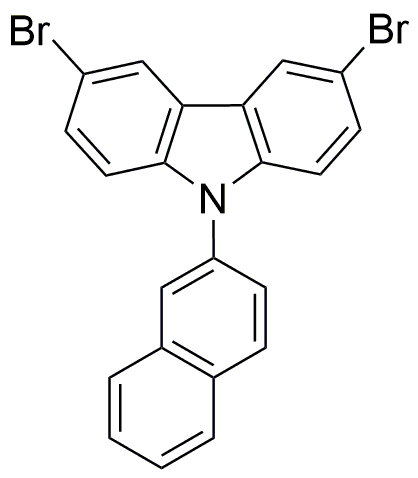3,6-Dibromo-9-(2-naphthalenyl)-9H-carbazole is widely utilized in research focused on:
- Organic Electronics: This compound is used in the development of organic light-emitting diodes (OLEDs) due to its excellent luminescent properties, enhancing display technologies in smartphones and televisions.
- Photovoltaic Cells: It serves as a key material in organic solar cells, improving energy conversion efficiency and contributing to sustainable energy solutions.
- Fluorescent Sensors: The compound is effective in creating fluorescent sensors for detecting environmental pollutants, aiding in environmental monitoring and protection.
- Biomedical Applications: Its unique properties make it suitable for use in drug delivery systems, where it can improve the targeting and efficacy of therapeutic agents.
- Research in Material Science: This chemical is valuable in the study of new materials for electronic applications, helping researchers innovate and develop next-generation technologies.
Informations générales
Propriétés
Sécurité et réglementation
Applications
3,6-Dibromo-9-(2-naphthalenyl)-9H-carbazole is widely utilized in research focused on:
- Organic Electronics: This compound is used in the development of organic light-emitting diodes (OLEDs) due to its excellent luminescent properties, enhancing display technologies in smartphones and televisions.
- Photovoltaic Cells: It serves as a key material in organic solar cells, improving energy conversion efficiency and contributing to sustainable energy solutions.
- Fluorescent Sensors: The compound is effective in creating fluorescent sensors for detecting environmental pollutants, aiding in environmental monitoring and protection.
- Biomedical Applications: Its unique properties make it suitable for use in drug delivery systems, where it can improve the targeting and efficacy of therapeutic agents.
- Research in Material Science: This chemical is valuable in the study of new materials for electronic applications, helping researchers innovate and develop next-generation technologies.
Documents
Fiches de données de sécurité (FDS)
La FDS fournit des informations de sécurité complètes sur la manipulation, le stockage et l’élimination du produit.
Spécifications du produit (PS)
Le PS fournit une description complète des propriétés du produit, notamment sa composition chimique, son état physique, sa pureté et les exigences de stockage. Il détaille également les plages de qualité acceptables et les applications prévues du produit.
Certificats d'analyse (COA)
Recherchez des certificats d'analyse (COA) en saisissant le numéro de lot du produit. Les numéros de lot et de lot se trouvent sur l'étiquette d'un produit, après les mots « Lot » ou « Lot de fabrication ».
Numéro de catalogue
Numéro de lot/série
Certificats d'origine (COO)
Ce certificat d'exploitation confirme le pays dans lequel le produit a été fabriqué, et détaille également les matériaux et composants utilisés et s'il est issu de sources naturelles, synthétiques ou autres sources spécifiques. Ce certificat peut être requis pour les douanes, le commerce et la conformité réglementaire.
Numéro de catalogue
Numéro de lot/série
Fiches de données de sécurité (FDS)
La FDS fournit des informations de sécurité complètes sur la manipulation, le stockage et l’élimination du produit.
DownloadSpécifications du produit (PS)
Le PS fournit une description complète des propriétés du produit, notamment sa composition chimique, son état physique, sa pureté et les exigences de stockage. Il détaille également les plages de qualité acceptables et les applications prévues du produit.
DownloadCertificats d'analyse (COA)
Recherchez des certificats d'analyse (COA) en saisissant le numéro de lot du produit. Les numéros de lot et de lot se trouvent sur l'étiquette d'un produit, après les mots « Lot » ou « Lot de fabrication ».
Numéro de catalogue
Numéro de lot/série
Certificats d'origine (COO)
Ce certificat d'exploitation confirme le pays dans lequel le produit a été fabriqué, et détaille également les matériaux et composants utilisés et s'il est issu de sources naturelles, synthétiques ou autres sources spécifiques. Ce certificat peut être requis pour les douanes, le commerce et la conformité réglementaire.


